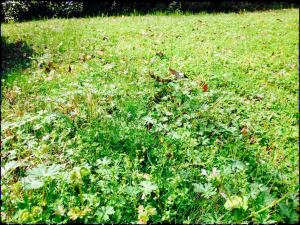If weeds were a problem in your lawn last summer, the coming weeks are the time to apply a pre-emergence herbicide to prevent their emergence again this spring and summer.
Timing of a pre-emergence herbicide application for summer annual weeds such as crabgrass should be during February when day temperatures reach 65° to 70°F for four to five consecutive days. This generally coincides with when azaleas and dogwoods first begin to bloom. This in not when these plants are in full bloom but when the first flowers begin to open along the lower branches, particularly on azaleas. Note: This timing is not true for chamberbitter. Chamberbitter requires warmer soil temperatures to germinate. Apply a pre-emergence herbicide during April when battling chamberbitter.
Most pre-emergent type herbicides won’t work when applied after weeds are visible. The product must be applied just before seedlings emerge.
The weeds growing now in local lawns are not summer annuals. Summer annual weed seeds are still dormant awaiting warmer spring temperatures to germinate and emerge.
Most of the weeds in yards now are winter annuals. A few include annual bluegrass, chickweed, henbit, hop clover, lawn burweed and wild geranium.
A pre-emergence herbicide should have been applied during October to help prevent these weeds.
A few common summer annual weeds include crabgrass, Florida pusley, chamberbitter, sandspur, spotted spurge and doveweed.
If your lawn has a history of summer annual weeds, one control option is to apply a pre-emergence herbicide. Timing is critical in order for pre-emergence herbicides to work.
Look for lawn pre-emergence products that contain the active ingredients oryzalin, benefin, pendimethalin, DCPA or bensulide.
For season-long weed control, a second application may be needed about six to nine weeks after the initial application. To activate some products, irrigation or rain may be necessary following application. Because pre-emergence products may interfere with lawn grass seed germination, delay re-seeding six to sixteen weeks after application.
Overuse of some types of pre-emergence herbicides can cause a lawn to produce short stubby weak roots. So only apply the product if there is a pest to control – in this case, if you have had a history of summer annual weeds. Otherwise, save your money and time. Use pre-emergence herbicides only on lawns that have been established for at least a year. These products can severely injure newly planted lawns.
It is the user’s responsibility to read and follow all label directions and precautions when using any pesticide, including herbicides.
- Know What You’re Doing when Amending Florida’s Sandy Soil - December 18, 2025
- Evaluate and Renovate Landscape During Fall - October 30, 2025
- Summer is Too Hot for Lawn Herbicides - August 23, 2025


